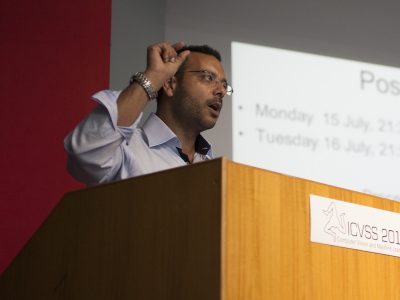
Research Activity
The activity will be based on the study of cognitive models and the implementation of proper modules for the simulation or the emulation of specific cognitive characteristics.
The reference architecture will be organized in three computational areas: the subconceptual area, concerning the level of elaboration of the perceptual data coming from the sensors; in this area, the information is not yet organized in terms of conceptual structures and categories; the symbolic area, concerning the symbolic elaboration of information; finally, a bridge between the subconceptual and the symbolic areas will be realized in the third area, named conceptual area. The data coming from the subconceptual area will be organized in conceptual categories that will not depend on the symbolic categorization. The symbols in the area will be anchored to the sensors’ data, mapping them to the representations of the conceptual area.
The innovation will consist of the integration, the definition, and the choice of the single components.
In particular, in order to implement the cognitive architecture of the system and the classic cycle of perception-reasoning-action, the following issues will be studied and developed:
Methodologies for noise elimination and extraction of information coming from the sensors
Social sensing methodologies to obtain a correct interpretation of the context. Special attention will be paid to the understanding of verbal and non-verbal social signs and the different social practices in which the interaction occurs.
Both symbolic and sub-symbolic methodologies for the representation of knowledge, reasoning, and learning. A key role will be played by the geometric representation of knowledge and the possibility to induce it from different sources of information such as, for example, data present on the web, social, or from sensors in general.
Planning techniques suitable to integrate with models of social practices to achieve a socially coherent interaction.
In order to involve more the user and communicate through different ways, we will integrate the following techniques and methodologies: A) techniques of sentiment/emotion analysis to explicitly understand and manifest feelings and emotions; B) methodologies of computational creativity in order to introduce variability and adaptability in behavior, with an improvement in the effectiveness of the processes of interaction between man, robot and environment.
Goals
The main models and architectures of Cognitive Sciences will be deepened. The research will include ethical and awareness aspects to integrate them into social robotics and Intelligent Autonomous systems. The intelligent system’s corporeality in which these models will be integrated will be a relevant element to consider; however, the approach will not be bound to a specific hardware platform. The main objective is to develop mechanisms oriented to increasing empathy and optimizing Human-Robot Interaction processes, maintaining an analogy of functions between the system and the human being. The proposed approach could also be used for social robotics, to model humanoid robot behaviors, and it will find applications in e-health, education, and social support in general. Finally, regarding intelligent automation, the goal is to design environments that can enter into symbiosis with the user by helping the well-being.
Application Fields
Robotics, Intelligent Automation, Ambient and Outdoor Assisted Living, Technology Enhanced Learning.


ANTONIO CHELLA

ERNESTO D’AVANZO

GIOVANNI MARIA FARINELLA

SALVATORE GAGLIO

IGNAZIO INFANTINO

ANTONIO LIETO

GIOVANNI ANTONIO MUSCATO

GIOVANNI PILATO

ARIANNA PIPITONE

FILIPPO VELLA


